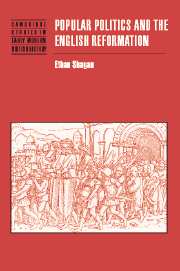Book contents
- Frontmatter
- Contents
- Acknowledgements
- List of abbreviations
- Note on the text
- Introduction
- Part I The break with Rome and the crisis of conservatism
- Part II Points of contact: the Henrician Reformation and the English people
- 4 Anticlericalism, popular politics and the Henrician Reformation
- 5 Selling the sacred: Reformation and dissolution at the Abbey of Hailes
- 6 ‘Open disputation was in alehouses’: religious debate in the diocese of Canterbury, c. 1543
- Part III Sites of Reformation: collaboration and popular politics under Edward VI
- Conclusion
- Bibliography
- Index
- Cambridge Studies in Early Modern British History
5 - Selling the sacred: Reformation and dissolution at the Abbey of Hailes
Published online by Cambridge University Press: 05 July 2009
- Frontmatter
- Contents
- Acknowledgements
- List of abbreviations
- Note on the text
- Introduction
- Part I The break with Rome and the crisis of conservatism
- Part II Points of contact: the Henrician Reformation and the English people
- 4 Anticlericalism, popular politics and the Henrician Reformation
- 5 Selling the sacred: Reformation and dissolution at the Abbey of Hailes
- 6 ‘Open disputation was in alehouses’: religious debate in the diocese of Canterbury, c. 1543
- Part III Sites of Reformation: collaboration and popular politics under Edward VI
- Conclusion
- Bibliography
- Index
- Cambridge Studies in Early Modern British History
Summary
On 11 November 1541, the gentlemen John Bridges, Richard Tracy and John Stratford received royal letters of commission directing them to investigate serious crimes committed on the site of a recently dissolved abbey in Gloucestershire. In the letters the king announced: ‘We are informed that great spoil hath been made by diverse persons, to us yet unknown, of the church and houses of the late monastery of Hailes, reserved to be defaced and sold or otherwise disposed to our use.’ He gave his commissioners ‘full power and authority’ to ‘search by all ways and means … what things of the said church and houses have been taken away, spoiled, or stolen, and by whom the same spoil hath been done’ and report their findings to the Court of Augmentations.
When the commissioners began their interrogation of suspects and witnesses in January 1542, they found a remarkable degree of disorder and deterioration. The plunderers of the abbey turned out to be not a small gang of misfits but an enormous collection of local characters, from servants and artisans to priests and gentlemen. Their destructive activities, moreover, had been remarkably efficient: the abbey, legally dissolved only two years before, was already practically unrecognisable. Hundreds of windows had been stolen, including ‘the great lattice windows’ of the church. With the windows went the valuable iron bars that held the glass in place.
- Type
- Chapter
- Information
- Popular Politics and the English Reformation , pp. 162 - 196Publisher: Cambridge University PressPrint publication year: 2002



